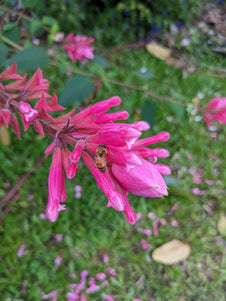





Salvia involucrata
Salvia involucrata

- In stock, ready to ship
- Inventory on the way

Usually available: All year
Life cycle: Perennial
Height: 2 - 3m
Position: Sun / part shade
Soil preference: Well drained
This is how we pack and send your Herb Plants to all states except TAS & WA
You will receive
- 1 Salvia Involucrata Herb Plant in a 50 X 75mm tube - General growing instructions
All of our Herb Plants are grown organically with certified organic potting mixes and fertilizers
Botanical Name:
Salvia involucrata is a tall, woody stemmed perennial growing up to 4 meters in ideal conditions. It is quite wide, with an arching habit and a spread of up to 1 meter. The dark green leaves are smooth and heart shaped have long stalks and grow to about 10cm in length. The 5cm tubular flowers have two lips and conspicuous pink bracts that fall off as the flowers grow bigger. They are held on one side of the stem and face upwards, as do the bracts. Flowering is from late autumn until early spring. Both the bracts and flowers have been described as being from deep cerise pink to beetroot like in colour. The deeper coloured purplish bracts occur is pairs and surround three flowers each. The leaves share the beetroot colour in the petioles and veins.
This salvia is also called Roseleaf Sage in deference to the rose coloured bracts that surround the flowers. It is native to the Mexican states of Puebla, Tamaulipas and Veracruz, where is grows in the shady forests borders. The name ‘involucrata’ refers to the prominent, large and colourful bracts.
Growing Conditions
S. involucrata prefers from half to three quarters a day of full sun for the best growth and flowering. A sheltered position with some shade provides a good location for this tall salvia. Rich and well drained soil is preferred, as is a good deep watering once a week. In early spring, the plant can be pruned back to ground level, ready to take advantage of the warmer temperatures and the first flush of new growth.
In cold or frost prone areas this salvia may die down and return with warmer temperatures. The plant can grow over a meter after returning in spring, before blooming in mid to late summer. It may be propagated by division or semi-hardwood cuttings from late summer to autumn. Alternatively, use soft wood cuttings taken in spring.
Roseleaf Sage has several popular cultivars of around 1.5 meters, with Bethellii and Boutin being the most popular of the older varieties. Each has won many awards for garden plants. Bethellii was introduced in 1881 and has a compact habit with large ovoid leaves. Other popular cultivars include Deschamsiana, from 1869, which is common in Britain and France. Hildago, El Butano and El Cielo are named for the areas in Mexico that they were collected from.
S. involucrata hybridises with other cultivars freely and has produced many hybrids such as old favourite Salvia ‘Joan’ or the newer dwarf salvia ‘Ripe Raspberry’. Many of the hybrids are tall at up to 1.8 meters, with long blooming periods. However, some more recent cultivars like ‘Mulberry Jam’, introduced in 1995, are smaller.
The salvia family has over 900 members with an extensive history as culinary, medicinal and ornamental plants. Ornamental salvias have become collectors items, as gardeners try to find a place in their garden for each and every one. There are salvias that will suit every type of soil and climate. More information on the Salvia genus and Common Sage (Salvia officinalis) may be found on our Common Sage page.
Medicinal Uses
Like many other salvias, S. involucrata has been used traditionally as a memory enhancer. Scientific studies have indicated that there are several compounds present in extracts of this salvia that have an affinity with acetylcholine receptors in the cerebral cortex.
All information provided on this website is for informational purposes only. Please seek professional advice before commencing any treatment.





